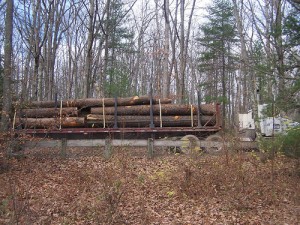
Logging is a process that involves cutting down trees and collecting the logs. These logs are then transported by a vehicle, usually a large logging truck, to locations where the logs are used for a variety of purposes, including for the manufacturing of log cabins and log furniture.
According to GovGuru.com, the following methods of logging are the most common methods. These methods are used all over the world and vary depending on the terrain on which the trees live:
Tree-length logging – When this method is used, the trees are felled and their limbs are removed. They are then topped at the stump. The logs obtained from these trees are taken to a landing area and are then loaded onto a vehicle, usually a truck.
Full-tree logging – This method involves felling the trees and transporting them to an area with their tops and limbs completely intact. But they are then topped and de-limbed at the landing area. Full-tree harvesting is also done to harvest trees by using the entire with the branches and tops still on it.
Cut-to-length logging – is a process of de-limbing, felling, bucking, and sorting at the stump of a tree. This leaves the tree limbs and tops behind in the forest. The harvesters collect the logs and put them in a pile, and they are then transported by a skidder truck or a forwarder to a landing area for later use. This is a common method that is used on trees that have a diameter of up to 900 millimeters. This method of logging is commonly chosen when trees are logged and harvested in areas of terrain that are somewhat steep.
Springboard logging – Springboards are tools that are used for this method of logging. This process involves loggers cutting a springboard notch into which they place a springboard. The springboard essentially acts like a platform and allows a logger to stand above obstructions like ice or snow in cold climates. It is also used as a method of cutting up higher on a tree where the tree trunk is more narrow.
Use LogFurniture.com to learn more about logging methods and how logs are actually collected prior to them being used for log furniture manufacturing purposes. It’s interesting to learn about how a log goes from the forest into your home, and many people are unaware of the hard labor that is involved in these pre-manufacturing processes.
